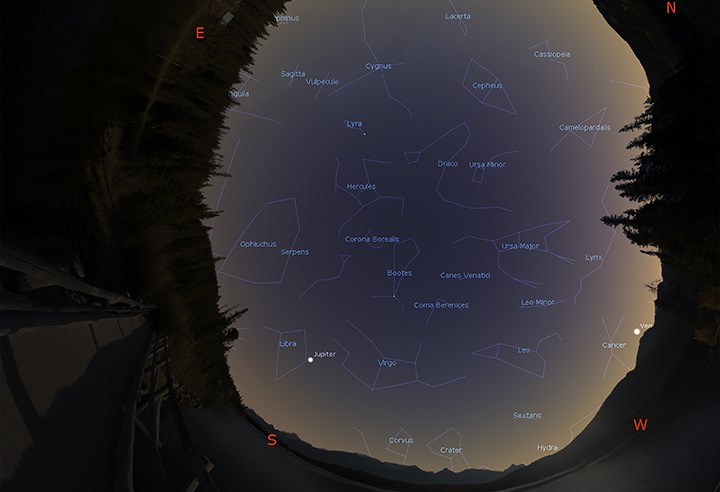
by Peter McMahon | special to the Fitzhugh
“Is it going to be dark enough to see anything?” This and variations of it are one of the first things our staff at the planetarium get asked by summer stargazers in Jasper.
And fair enough: Ironically, the latest sunsets of the year happen when most of the tourists start to roll into town, searching for dark skies and bright stars.
Despite this challenge, we find that June is one of the most magical months for us to show the wonders of the cosmos to aspiring ‘polar fleece astronomers’. And you can see some of these things too.
First ‘star’ you’ll see tonight
Before it even gets dark, you can spot two planets in the sky this June starting around 10:30 pm.
From the Jasper town site this month, you can look up and see the first point of light of the evening: Venus, setting in the west over the Pyramid Bench (the town-spanning terrace that leads up to Pyramid, Patricia and other lakes.)
Once thought to be a tropical version of Earth, we now know that Venus is a hellish world.
With a surface temperature close to that of your oven on the cleaning cycle, sulfuric acid rain, and 90 times the surface pressure of Earth, we joke to guests that Venus doesn’t have very good Tripadvisor reviews.
Through a telescope, Venus goes through ‘phases’ as seen from Earth, looking like a flaming white marble at times, and at other times appearing as a thin crescent.
A solar system within a solar system
Around the same time, another bright star-that’s-not-a-star reveals itself this month as it rises in the southern sky, just to the left of the Whistlers.
At 1,300 times the size of Earth, Jupiter is so big that it can fit all the other planets of our Solar System inside it. Several of its 69 moons are as big as the planet Mercury. In-fact, if Jupiter were only a few dozen times bigger, it would begin nuclear fusion and burn as a second ‘Sun’.
Through a telescope, we’ve seen multi-coloured bands of gas swirling around Jupiter, the Earth-sized Great Red Spot (a 300-year-old oval-shaped storm), four of Jupiter’s moons, and even the shadow of one of the moons on the planet.
You can see Jupiter without optical aid as a ‘star’ that gets brighter and brighter as it rises higher while the sky gets darker.
If you have a pair of binoculars, point them at Jupiter and you might be able to see the moons as dim stars to the immediate left and/or right of the planet (so close they may almost seem to be touching the planet.)
Into the deep (space)
While spending all this time finding and looking at planets, you might have noticed it finally started to get dark.
Even before it’s absolutely pitch-black, you can start to see bright star patterns like the Big Dipper, Little Dipper, Cassiopeia (that W or M shape), and Lyra, the harp (thought I’ve always thought it’s more of a smartphone shape).
It’s in Lyra (which soars over Mount Tekarra in June, as seen from the Jasper town site) that we get one of our first looks into deep space.
Through a telescope, Lyra gives up the sky’s coolest early-evening secret: the Ring Nebula. This multicoloured donut-shaped shockwave is the leftover shell from the explosive death of a distant star.
While there’s nothing like seeing planets, stars, galaxies and more through telescopes, you can see the above constellations in Jasper by just looking up, getting to know your way around a sky that will only get darker and more interesting as summer continues in Jasper Dark Sky Preserve.
Peter McMahon is a space author and journalist and general manager of The Jasper Planetarium.



